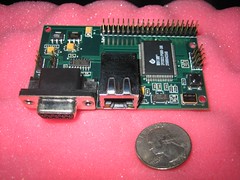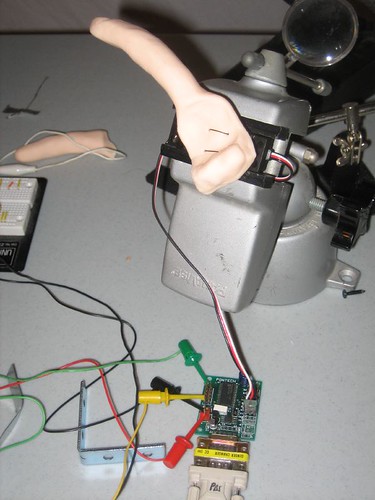Wednesday, May 31, 2006
Cheap analog ultrasound ranger
I was worried that I can find any more of the ultrasonic rangers I used on Blame, but now there is MaxSonar-EZ1 with RS-232, analog, and PWM range output.
RVHEs arrived
The RVHE's arrived. And yes, within a few minutes I had power applied and was able to work interactively using Hyperterm with the BASIC interpreter. They are smaller than I thought they were:

A 40 pin header cable may come in handy...

A 40 pin header cable may come in handy...
Cheapest Embedded PC w. Video?
In the vein of embedded PCs, the eBox-2600 is fanless, has VGA, Ethernet, and a full parallel port for digital interfacing, all for $194 from WDL.
PC-104 links
What really sucks about PC-104 SBCs is 1) they cost too much and 2) you can't find online pricing.
Not much can be done about #1, but Notes on PC/104 Hardware for FreeBSD pointed me to WDL Systems which actually has prices listed!
I still think I made the right decision in going with RVHE boards for Touch instead of PC-104 SBC PCs. The PC-104 solutions would be three to four times as much. Most of what I do doesn't need that much CPU power or expandability.
Not much can be done about #1, but Notes on PC/104 Hardware for FreeBSD pointed me to WDL Systems which actually has prices listed!
I still think I made the right decision in going with RVHE boards for Touch instead of PC-104 SBC PCs. The PC-104 solutions would be three to four times as much. Most of what I do doesn't need that much CPU power or expandability.
More info on using CF for IDE drives
Here are two good references for the use of Compact Flash (CF) as IDE drives in computers: Linux Router Project (LRP) using Compact Flash and Compact Flash as an Alternative to Hard Drives in Arcade Games
Tuesday, May 30, 2006
Cheap embedded PC?
I have gone ahead and ordered two RVHE's for the touch project.
Today I came across an ultra-cheap embedded PC, the KuroBox HG WR which lists for $149. It has a 266Mhz PowerPC, 128MB of RAM, 2 USB 2.0, and GigE with a quiet 22dB fan. It says there is an internal 6-pin serial connector as well. It looks like it doesn't have VGA of any kind. It comes with a base Linux install with telnet, ftp, and web.
KuroBox doesn't come with a drive, but can take an IDE drive. Perhaps a 1GB IDE Flash drive for dependability. There are also IDE to CF ($11.51) adaptors, so you could use a 1GB CF card ($41)
Today I came across an ultra-cheap embedded PC, the KuroBox HG WR which lists for $149. It has a 266Mhz PowerPC, 128MB of RAM, 2 USB 2.0, and GigE with a quiet 22dB fan. It says there is an internal 6-pin serial connector as well. It looks like it doesn't have VGA of any kind. It comes with a base Linux install with telnet, ftp, and web.
KuroBox doesn't come with a drive, but can take an IDE drive. Perhaps a 1GB IDE Flash drive for dependability. There are also IDE to CF ($11.51) adaptors, so you could use a 1GB CF card ($41)
Monday, May 29, 2006
Two-Way Differential Touch
Hree is a video of true two-way touch that used the differential between the pressure on both fingertips.
(If you can't see the embedded object, try here).
(If you can't see the embedded object, try here).
Saturday, May 27, 2006
Touch prototype: Two Fingers
I now have two fingers, on the tip of each finger is a pressure-sensitive resistor. A really slow Windows 98 machine I happened to have is running a program in Python which works with a serial-to-servo-and-A/D interface for the two fingers. If you can't see the video below, try the direct link.
Thursday, May 25, 2006
Eyebeam: Circuit #2
Also in Chelsea on Saturday, I got to see Circuit #2 where "emerging artists working with technology the opportunity to take over Eyebeam's exhibition space for three days and participate in critiques, roundtables and public presentations." The artists gave presentations, of which I was able to catch a few, and there was free beer as well.
Geoffrey Bell's Musical Chair: A Game For One has a video camera which images the viewer who sits in a chair. The image is split into six square segments, each one with a different time delay, and the time delayed segements are rejoined and projected onto a screen. The effect is that when you stay in one place on the chair, the projection looks normal. But if you begin to move around, the different time delayed segments decohere and the combined image is quite chaotic, until you stop again and all the segments catch up to your non-moving state and it looks normal again.
Ernesto Klar's Convergenze parallele images the dust moving in the air, and converts that to an audio signal and a video projection. I suggested to Klar that he look into cloud chambers to do a similar thing with trails of radiation.
Marta Lwin presented polymorphic [d(eoxyribo)n(ucleic) a(cid)]: a love story, an installation where the disembodied lips of her and her partner take turns "talking" the letters of DNA of part of their genome. I totally support all genetic art!
She also previously has done work creating wearable jewelry from skin cell cultures grown on biodegradable scaffolds.
Geoffrey Bell's Musical Chair: A Game For One has a video camera which images the viewer who sits in a chair. The image is split into six square segments, each one with a different time delay, and the time delayed segements are rejoined and projected onto a screen. The effect is that when you stay in one place on the chair, the projection looks normal. But if you begin to move around, the different time delayed segments decohere and the combined image is quite chaotic, until you stop again and all the segments catch up to your non-moving state and it looks normal again.
Ernesto Klar's Convergenze parallele images the dust moving in the air, and converts that to an audio signal and a video projection. I suggested to Klar that he look into cloud chambers to do a similar thing with trails of radiation.
Marta Lwin presented polymorphic [d(eoxyribo)n(ucleic) a(cid)]: a love story, an installation where the disembodied lips of her and her partner take turns "talking" the letters of DNA of part of their genome. I totally support all genetic art!
She also previously has done work creating wearable jewelry from skin cell cultures grown on biodegradable scaffolds.
Peter Vogel at Bitforms
Last Saturday, I hit the Chelsea Galleries in New York. I didn't do any preparatory research, I just like walking around the few blocks and hitting some favorite galleries including Bitforms.
Much to my surprise, Bitforms had a Peter Vogel solo exhibition. I first ran into his work at another gallery in Chelsea, when in a back room I saw one of his incredible sculptures.
Vogel takes a large number of discrete electrical components (resistors, capacitors, transistors, etc.), and solders them together into self-supporting, truss-like forms. But then I moved between a light and the sculpture and it started making music! The discrete components were not only visually beautiful, but also functional analog audio synthesizers!
I thought this was pretty cool, and asked about the work. I was quite surprised to find out it was made in the 1960's! Evidently Vogel has been doing this kind of work for quite a while.
At the Bitforms exhibition, the earliest work was from 1979. There were several sculptures that use Cadmium Sulfide photoresistors to trigger the audio synthesizers. There also were works that modulated trains of LEDs based on audio input through electret microphones. In one room, an audio synthesizer sculpture would trigger the LEDs in an audio input sculpture for a very neat effect.
I had a chat with one of the Bitforms staff about how they handle the "warranty" issues of technological art. Apparently Bitforms tries to address this issue through thorough documentation of the work, so that if say a capacitor dries out, you know what kind to purchase. Of course, one wonders if in 20 years you still will be able to purchase 4000 series CMOS chips, for example. With enough documentation, at least it could possible be re-created (with PLAs? Quantum logic chips? who knows!)
Much to my surprise, Bitforms had a Peter Vogel solo exhibition. I first ran into his work at another gallery in Chelsea, when in a back room I saw one of his incredible sculptures.
Vogel takes a large number of discrete electrical components (resistors, capacitors, transistors, etc.), and solders them together into self-supporting, truss-like forms. But then I moved between a light and the sculpture and it started making music! The discrete components were not only visually beautiful, but also functional analog audio synthesizers!
I thought this was pretty cool, and asked about the work. I was quite surprised to find out it was made in the 1960's! Evidently Vogel has been doing this kind of work for quite a while.
At the Bitforms exhibition, the earliest work was from 1979. There were several sculptures that use Cadmium Sulfide photoresistors to trigger the audio synthesizers. There also were works that modulated trains of LEDs based on audio input through electret microphones. In one room, an audio synthesizer sculpture would trigger the LEDs in an audio input sculpture for a very neat effect.
I had a chat with one of the Bitforms staff about how they handle the "warranty" issues of technological art. Apparently Bitforms tries to address this issue through thorough documentation of the work, so that if say a capacitor dries out, you know what kind to purchase. Of course, one wonders if in 20 years you still will be able to purchase 4000 series CMOS chips, for example. With enough documentation, at least it could possible be re-created (with PLAs? Quantum logic chips? who knows!)
Monday, May 15, 2006
First finger of the hand
Subscribe to:
Posts (Atom)
